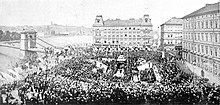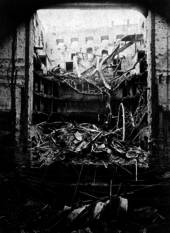Národní divadlo
The National Theater ( Národní divadlo in Czech ) is the most important theater and opera house in the Czech capital, Prague . The building in the New Town , located on the Vltava and opened in 1881, was built in the neo-renaissance style with the help of donations mainly from the Bohemian countries and is considered a national symbol.
history
The idea of building a Czech national theater in Prague came up as early as 1844, whereupon František Palacký submitted a corresponding application to the Bohemian state parliament on January 29, 1845 , which was approved. The association's first public appeal for donations for the construction of a Czech National Theater in Prague was issued six years later, in April 1851. A total of 3.2 million guilders (80–90 million euros ) were collected from donations and lotteries for the construction of the theater by 1884 .
First a temporary theater was built, the Interim Theater ( Prozatímní Divadlo ) , which opened in 1862 , before members of the association around Karel Sladkovský , Miroslav Tyrš , Jan Neruda and Vítězslav Hálek asked the architect Josef Zítek to submit a design in 1865 , which then won the tender.
The exhibition at the start of construction was visited by Emperor Franz Joseph I , who on the occasion donated a personal contribution of 5,000 guilders. (After the fire in 1881 he donated a further 13,000 guilders.) Members of the imperial family donated 26,000 guilders, other donors were the Russian tsar and the Czech nobility: the families Chotek , Kolovrat , Schwarzenberg , Kinsky , Czernin , Nostitz , Harrach and others. The emerging middle class also made a significant contribution.
The first cornerstone came to Prague from Radhošť in Moravia on May 5, 1868. Other stones from Bohemian mountains such as Říp , Vyšehrad or Blaník followed. On May 16, 1868, the start of construction was celebrated in the presence of 100,000-150,000 spectators, the climax of which was the premiere of the opera Dalibor by Bedřich Smetana in the Novoměstské divadlo (New Town Theater).
By the end of 1868 the foundations had been laid; thereafter construction proceeded only slowly. In 1877 the roof was put on. In 1873 a tender for the interior of the building began, the designs of which had been drawn up by a commission under the leadership of Sladkovský. The concept envisaged a classic interior in the sense of the neo-Renaissance - inspired by the prevailing enthusiasm for Slavic mythology and medieval manuscripts ( see: Grünberger and Königinhofer manuscript ). Bohuslav Schnirch , Josef Václav Myslbek , Václav Brožík , Mikoláš Aleš , Vojtěch Hynais , Julius Mařák and František Ženíšek were involved in the realization .
On the occasion of and in honor of Crown Prince Rudolf's visit , the theater, which had not yet been fully completed, was opened prematurely on June 11, 1881 with the premiere of the opera Libusa, which Smetana had composed especially for the occasion in the early 1870s . After eleven more performances, the building was closed again for the outstanding work.
Before the final opening, there was a fire on August 12, 1881, which destroyed the brass dome as well as the stage and the auditorium. After another collection of donations, which brought in more than one million guilders, and the insured sum of almost 300,000 guilders, which the first Czech mutual insurance company paid out, it was rebuilt in the following years under the direction of the architect Josef Schulz . Janez Šubic created the interior frescoes based on designs by Mikoláš Aleš and František Ženíšek. The second opening took place on November 18, 1883 again with a performance of Smetana's Libusa .
There was no major renovation for almost a hundred years until the theater was thoroughly restored from 1977 to 1983. The first performance took place exactly one hundred years to the day after the second opening, on November 18, 1983. From 2012 to 2015 the outside of the building was completely renovated. Game operations continued.
Since August 1, 2019, the Norwegian Per Boye Hansen has headed the National Theater and State Opera .
Other venues
- The Nová scéna (New Scene) is a brutalist style theater building built by Karel Prager from 1977 to 1983 , which is located next to the National Theater. The new scene is performed by the Laterna Magika ensemble .
- The Estates Theater on Ovocný trh (Fruit Market) in Prague's Old Town has been under the administration of the National Theater since 1920
- In 2012 the Prague State Opera was incorporated into the National Theater, which is why the two large Prague opera houses are now united in one institution.
literature
- Oscar Teuber: History of the Prague Theater. From the beginnings of acting to the very latest . KK Hofbuchdruckerei Andreas Haase, Prague 1883. Various modern reprints. Digitized online
- Zdeňka Benešová, Taťána Součková, Dana Flídrová: Národní divadlo - historie a současnost budovy (The National Theater - Past and Present of Construction ), Edition Národní divadlo, Prague 1999.
Web links
- Web presence of the Národní divadlo (Czech / English)
- Opera company of the Národní divadlo (Czech)
- Radio Prague on the founding history of the Prague National Theater
Coordinates: 50 ° 4 ′ 51.2 " N , 14 ° 24 ′ 49.7" E




